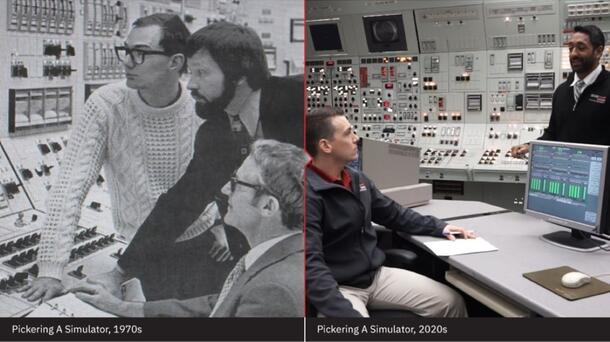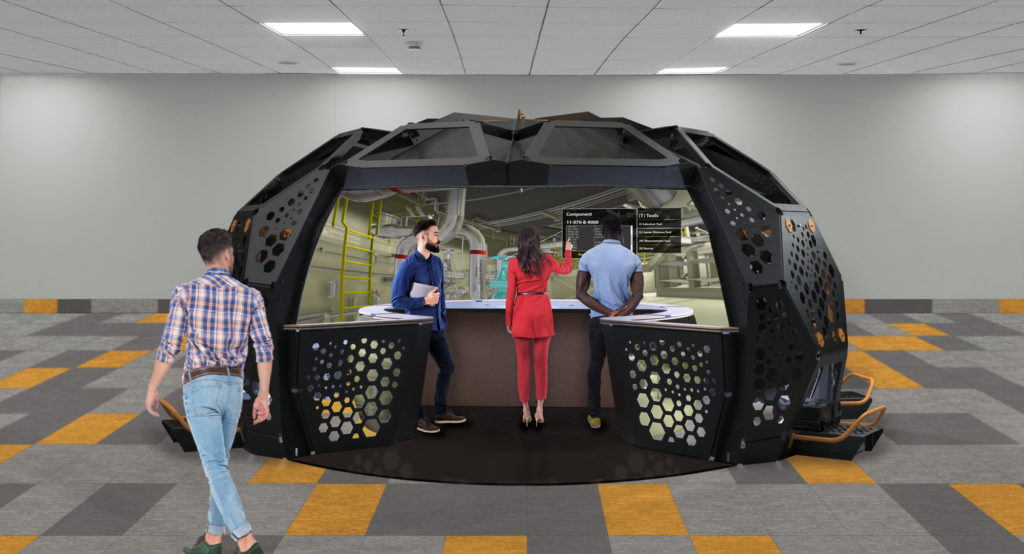Nuclear Training Never Stops Advancing – Tools And Methodologies Supporting Innovation
Interview with Michael H. Chatlani, Vice President, Business Development – Power Systems and Simulation at L3Harris
The nuclear sector experiences continuous innovation in all its fields. New nuclear projects feed a growing demand for the workforce. At the same time, innovative training methodologies and approaches rise to support skills development and management for these future plans.
In the Year of Skills, we continue the discussion together with Michael H. Chatlani, Vice President, Business Development – Power Systems and Simulation at L3Harris (ENS Corporate Member), a global leader in nuclear innovation technologies and solutions.
L3Harris celebrates this year its 50th anniversary of providing nuclear power plant simulators for plant operators and engineers worldwide. Could you explain to our readers what L3Harris is and how it developed over the past half century? Could you please highlight a few main achievements of L3Harris?
L3Harris delivers end-to-end technology solutions connecting the space, air, land, sea and cyber domains. Our 46,000 employees are focused on customers’ mission-critical needs.
In 1973, the Montreal operations of L3Harris started collaborating with Ontario Power Generation (then Ontario Hydro) to develop a first-of-a-kind operator training simulator for a CANDU (PHWR) nuclear facility – Pickering A. When we entered into this relationship, we were part of CAE – a technology company, with our main focus on full flight aircraft simulators. Nuclear was new to us but the team was motivated, talented and we had a great partner and knowledgeable customer in OPG. They played a large role in guiding us on how the plant works and in testing the simulator, which was put into service in 1976.
L3Harris began construction of its first nuclear power plant simulator in 1973 for Ontario’s Pickering A site. Ph. L3Harris
In the early 1980s, we had expanded to the US market, providing operator training simulators for both pressurized and boiling light water reactors. L3Harris’ high-fidelity, plant-specific simulators have now been deployed in 22 countries across five continents.
Over the past 50 years, L3Harris supplied advanced plant models and numerous state-of-the-art simulators – including full-scope operator training simulators, part-task trainers, classroom training touchscreen simulators, 3D immersive simulators and engineering simulators. These simulators address a range of needs from enhancing operator training in normal and off-normal situations, to testing new control systems, new plant designs, existing plant changes, human factors studies, and cyber intrusion exercises.
There are many achievements to speak of regarding our global market penetration, our business process improvements and our technology. For now, I will focus on a few technological achievements of which I am especially proud.
In 1991, we released an object-based, drag-and-drop simulation environment, called ROSE®. This was a major turning point for us. Customers started to recognize that we were here to stay and offering truly innovative solutions. ROSE®, now known as Orchid® Modeling Environment is used for modelling plant systems for power plant simulators and developing control sequences for naval control systems. It also effectively serves as a rapid prototyping environment because systems that are implemented in Orchid® Modeling Environment can be dynamically and visually tested without the need for additional software packages. The Orchid® software tools are widely recognized for their ease of use and interoperability and are what set us apart from our competition.
We were recently tasked with building an engineering simulator for a Generation IV molten salt Small Modular Reactor (SMR), developed by Terrestrial Energy. To develop the Integral Molten Salt Reactor (IMSR) power plant models, we had to modify our Orchid® Core Builder and Orchid® Modeling Environment tools to accommodate liquid nuclear fuel and molten salts that move through the reactor. Our engineers embraced the challenge. The high-fidelity implementation, with Terrestrial Energy’s support, demonstrated that the IMSR power plant will fulfil its potential as a clean energy source. Incidentally, Terrestrial Energy announced on 18 April 2023 that it had completed Phase 2 of the Canadian Nuclear Safety Commission’s (CNSC) pre-licensing Vendor Design Review—the first advanced, high-temperature fission technology to reach this milestone. The CNSC concluded that here are no fundamental barriers to licensing the IMSR plant.
A key factor in our Orchid® technology decision-making is that the technology is designed for applications in both nuclear and marine projects, providing great synergies. A good example is the graphical, drag-and-drop scenario manager in Orchid® Instructor Station. It was first deployed for a naval training simulator in the Netherlands and is widely used in our nuclear plant simulators worldwide.
We continue to innovate as we move forward with the solutions of the future to meet the needs of a new generation of workers. Our most recent redesign of Orchid® Instructor Station has a new simpler user interface that is easier to use than anything else on the market. In addition to conventional point-and-click operation, it now supports touch gestures (swiping, pinching, tapping, etc.) and has been very well-received by our user community.
From well before the initial releases of the technologies through their lifecycle, there is robust continuous investment. Technological leadership in the markets we serve is not an option for us. It, along with how we intently listen to and engage with our customers, is what I believe best defines who we are.
How did the training methods and approaches change over these five decades?
Nuclear training, like training in other safety critical industries, is based on the Systematic Approach to Training (SAT) methodology. It has proven to be effective and is considered an international best practice. There are four main training modalities in use: classroom training (basically “chalk and talk”), team training on the operator training simulator, on-the-job training, and laboratory/mock-up/workshop training.
The International Atomic Energy Agency (IAEA) and others have promoted increased use of Computer Based Training (CBT) over the years. Except for operator training simulators that have continued to improve over time, there has not been much adoption of CBT or other classroom technologies.
While the industry has gone from overhead transparencies to PowerPoint (or equivalent) presentations in the classroom, it is still lecture-based. Of course, the SAT-based training design and training delivery have proven to be very positive for performance-based training—and will continue to do so going forward. We expect much greater use of technology inside and outside of the classroom and have been working on enabling technologies for a decade. We need to make digital content more accessible to all learners—both existing nuclear training organisations and new-to-nuclear countries and states.
Earlier this year, the Institute of Nuclear Power Operations (INPO) released a guideline for advancing teaching and learning in the industry. We are encouraged by this as it advocates for nuclear power utilities to move beyond conventional training methods. Utilities are being encouraged to identify and use innovative methods to promote continuous learning. We have been saying the same for several years, but not only for continuous learning.
How did digitalisation impact the E&T sector?
There are many forms of digitalisation. What makes digital tools successful is how easy they are to use. It’s a lot to ask of end-users to embrace cumbersome technology. Digitalisation is already in most of the work that we do. L3Harris has been blessed over the years with customers that were/are willing to onboard our newest technologies. Beyond process simulators and engineering simulators, I’ll provide an example of digitalisation that we are involved in.
The Orchid® IX technology offers full-scale 3D immersion for enhanced training and facility support. Ph. L3Harris
Imagine a realistic 3D visualisation of an entire nuclear facility that is dimensionally accurate and that users can be immersed in—and it operates! Imagine if users could access such technology at their desks or even go into an immersive theatre that surrounds them to experience it. Now imagine if they, as a group, could be immersed without the use of VR headgear. There is no need to imagine this—we have done it! A gigawatt size nuclear plant is already using this 3D immersive simulator technology. In addition to training and supporting operations, many other plant groups are taking advantage of this innovation; namely, engineering, maintenance, work planning, outage teams, maintenance planners, start-up teams, radiation protection and fire protection. With such virtual representations, and other work that we are doing, we are firmly on the path to accomplishing nuclear plant digital twins.
What are the new training methodologies and approaches that L3Harris currently deploys?
We already spoke about technological improvements that are needed and how we present materials to the learner for better and faster learning. We have gone the next step and designed a nuclear training program for nuclear learning in the 21st century, called NucLearn21. It covers nuclear fundamentals, systems training and operations training. It capitalizes on accessible visual technology embedded in the courseware for both synchronous and asynchronous training.
We believe today’s learners should have access to interactive 3D animations to visualize equipment, rather than 2D cutaways. Similarly, they should be able to understand and experience systems with easy-to-use simulations, rather than flipping through marked-up flow diagrams. This is our latest offering for nuclear newcomers – available even before they select the nuclear technology that is right for them.
Exploring nuclear system with interactive, visual learning technology. Ph. L3Harris
How do you see the global situation of the nuclear workforce today? And what about North America?
Except for a handful of countries, we haven’t seen many large-scale nuclear build outs or major plant refurbishments over the past few decades, both in North America and globally. This means that in many nations that have nuclear power assets, we have been in operations and maintenance mode. As you know, nuclear facilities operate for decades, provide good benefits, and a stable work environment. This has led to an ageing workforce that are very talented, but there have been many retirements in recent years and there are more to come. The sector is cognizant of this and has been working on adding younger workers to their organisations for years, but as the sector ramps up for new nuclear generation, we will need to double up efforts on hiring, retention and making the sector attractive.
For those countries that have continuous major programs ongoing, they have created better conditions to attract and retain personnel. Here, I am not only speaking of personnel that work at the nuclear facilities, but the supply chain as well. Like many other major infrastructure projects, there is a whole ecosystem that is needed to support the projects, both during construction or refurbishment and during operation.
The situation is evolving. With federal, provincial, and regional governments working to tackle climate change and to ensure their own energy security, nuclear energy – both from large and small modular nuclear assets – is set to grow at a pace and scale never seen before. We expect to see more nuclear plants being built in countries that already operate nuclear plants and in newcomer countries that have a need to address these issues. Moreover, new-to-nuclear nations will emerge because nuclear power plants will provide lower to middle income nations with an abundance of reliable electricity that will drive prosperity and growth. As this is happening, there will be a growing need for skilled tradespeople and nuclear professionals. The worldwide demand will result in competition for these resources both during construction and for operation and maintenance.
We will need to develop industry professionals more quickly. The new nuclear workforce will primarily be younger people. We will need the training media to be well-suited for younger learners who are more comfortable in a less linear form of learning that provides for experiential and some self-directed learning. L3Harris is already well on its way to introducing the technologies and training materials for the next generation of nuclear workers.
Let there be no doubt to youth considering coming into the nuclear sector: there are many opportunities for rewarding careers, both for university graduates and skilled tradespeople.
Beyond skills development and management, talent acquisition is important too. What is L3Harris doing to attract new talents? And what do you think the nuclear sector should do to make itself more attractive?
As L3Harris is largely in the technology side of the sector – and as mentioned earlier, there is always continuous investment in innovation, we do not have significant issues with attracting bright people to work in our business areas, even though the market for engineers and technologists is highly competitive. Moreover, because our nuclear power systems and simulation business is laser-focused on making our software tools easy to use and understand, this allows us to easily onboard and train university and college graduates. Our software tools are used in more than one sector. Our investment in people in one sector allows us to engage them in other sectors as well.
Focusing specifically on the nuclear power sector, the challenge has been the same for the last few decades: ensuring there are sufficient, quality projects. We have done well considering that the sector has largely been in operations and maintenance mode – and this is a testament to our people, continuous investment in the Orchid® technology and global reach. When customers dig into know-how and technology capabilities/features to support their long-term training and engineering needs, customer evaluations tend to favour L3Harris. We have also benefited from worldwide market awareness – generating business in only a few countries in the nuclear training and simulation domain would have been unsustainable.
As mentioned earlier, our sector creates great, long-term jobs where you can grow your career and are offered employment security in a healthy work environment. As we go through the next phase of growth—and it’s happening—we need to get the word out that we have a great work environment and make it clear and widely-known that our work beautifully aligns with protecting our environment, creating prosperity and even supplies products (e.g. medical isotopes) to save lives.



